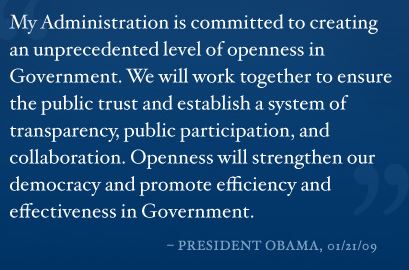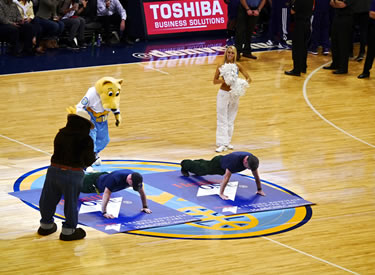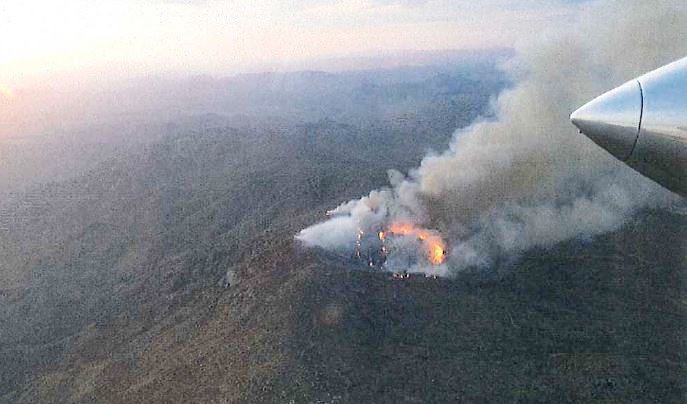After one of the driest winters on record, California’s 2013 fire season was extremely active. The lack of winter rains resulted in dry conditions across the state leading to a number of unseasonably large wildfires early in the year and a continued trend of above normal fire activity. This YouTube video summarizes the activity across the state this year.
Author: Bill Gabbert
Failures of the “Open Government Initiative”

Unfortunately we have had to run this image previously on Wildfire Today when we pointed out examples of the U.S. Forest Service flagrantly violating the Open Government Initiative established by President Obama.
The latest occurrence is the agency’s refusal to fully cooperate with the investigations into the deaths of the 19 members of the Granite Mountain Hotshots on the Yarnell Hill Fire in Arizona on June 30. The U.S. Forest Service provided so little information that it was described as “useless” by one of the investigation teams, short-circuiting an opportunity to learn lessons that may prevent future tragedies. They supplied heavily redacted documents and would not allow a hotshot crew that was working nearby during the accident to be interviewed. The agency cited the Privacy Act of 1974 as the reason for their intransigence. In the hundreds of investigation reports of serious accidents that have been completed over the last 80 years, I don’t recall any others in which the USFS refused to allow their employees to be interviewed due to the Privacy Act of 1974 or other similar concerns.
At Fire Aviation we first asked for a list of Type 1 helicopters that were on exclusive use contracts on April 16, 2013, hoping to receive it well before the western wildfire season got underway. We were told that the list was only available if we filed a Freedom of Information Act (FOIA) request, which we did. After many delays, uncountable emails, excuses, and receiving incorrect information, we finally got it on September 26, five months after asking for it. Federal agencies are required to respond to a FOIA request within 20 business days. In this case it took 167 days including weekends.
The USFS refused to release the $840,092 RAND air tanker study even after we filed a Freedom of Information Act Request. The agency told Wildfire Today “…the report is proprietary and confidential RAND business information and must be withheld in entirety under FOIA Exemption 4″. Finally RAND released it two years after it was completed, but as far as we know the USFS never did. Somehow the USFS concluded that Exemption 4 did not apply to the other air tanker studies that have been completed, some of which were also done under contracts to private companies.
Hotshot crews honored at preseason opener for Denver Nuggets
Provided by Phil DeSennze, Rocky Mountain Region, U.S. Forest Service
The National Basketball Association’s Denver Nuggets honored U.S. Forest Service Hotshot crews and first responders throughout the state of Colorado at a recent Fans and Heroes Night at the Pepsi Center in Denver.

cheer on Pike Interagency Hotshot Crew members, Michael Alexander and
Bob Ayotte in a push-up competition at center court.
(U.S. Forest Service photo by Todd Riecks)
The U.S. Forest Service participated in activities before, during and after the game with Smokey Bear attending his first NBA game in Colorado. Smokey encouraged fans to be prepared for emergencies and gave two big “paws up” to the men and women who serve their communities as first responders.
Before the game, Smokey and Forest Service employees greeted fans of all ages and provided giveaways and information about emergency preparedness and wildfire prevention. Emergency vehicles were on display, including a fire engine from the Pike National Forest. Emergency responders and children took their picture with Smokey. The Nuggets gave first responders and their friends and family complimentary and discounted tickets to the game. Pictures of first responders in action were displayed during game breaks on the Pepsi Center’s new high-definition JumboTron, while law enforcement, firefighters and medical professionals were recognized throughout the night. Three Forest Service public service announcements also played during the game.

with Nuggets mascot Rocky at center court.
(U.S. Forest Service photo by Todd Riecks)
Smokey made his rounds during the game and even took the court with Rocky, the Nuggets’ mascot. Captain Drew Maxwell from the Pike National Forest took part in the color guard before the game and presented the game ball to the referees. Bob Ayotte and Mike Alexander, Hotshots from the Pike National Forest, displayed their fitness with a push-up competition at center court during a timeout in the third quarter. Fans and players looked on in amazement as these Hotshots did almost 40 push-ups in 30 seconds, displaying the level of preparation it takes to belong to the ranks of these elite first responders.
“This event provided an outstanding opportunity for us to interact with an urban population and help spread Smokey Bear’s fire prevention, fire safety and outdoor opportunity messages,” said Alexander, assistant superintendent of the Pike Interagency Hotshot Crew.
Thousands of fans stayed after the game to participate in an evacuation drill in cooperation with the Denver City Police and Fire departments. Participants received prize packs, which included regular season tickets and autographed memorabilia, along with emergency preparedness kits.
The event was a great opportunity to create a new partnership with the Nuggets and first responders throughout the state, as well as build awareness among the community about the importance of fire prevention
Firefighters’ hockey tournament raises funds for Wildland Firefighter Foundation
There have been many fundraising events to raise money for the Wildland Firefighter Foundation, including golf tournaments, runs, ice fishing, and even a scavenger hunt. But firefighters in Minnesota will be holding their third annual Fire on Ice Hockey Tournament January 18, 2014 in Walker, Minnesota. Proceeds from the tournament and a raffle will benefit the WFF. Last year they raised $2,500 for the private non-profit organization that supports agency, municipal, volunteer, and private firefighters in ways insurance and other sources cannot when there is a firefighter injury or fatality.
The hockey players are required to at some point in their lives have held a “red card” (fire qualifications card). The teams this year will represent:
- U.S. Fish and Wildlife Service
- Superior National Forest
- Minnesota Department of Natural Resources
- Minnesota Incident Command System (MINICS)
The raffle prizes include items that you will not see in other fundraisers around the country, such as a free four-day rental of a four-person 8′ x 16′ sleeper fish house located on a frozen lake, or a power ice auger.
Thanks go out to Mike
Wildfire briefing, December 9, 2013
Hunter to be charged for starting Rim Fire
A hunter is expected to be charged for acts that resulted in starting the Rim Fire, which this summer burned 402 square miles of forest in and near Yosemite National Park in California. Sfgate.com reported that Michael Knowles of the U.S. Attorney’s office has indicated that charges will be filed, but the identity of the person has not been revealed. Fire officials said earlier that a hunter’s illegal campfire was the origin of the blaze.
Reporter remembers writing the story about the South Canyon Fire
A reporter has written an interesting article about what it was like to first hear the news and write the story of the 14 firefighters that were killed on the South Canyon Fire near Glenwood Springs, Colorado in 1994.
Billie Stanton was working in the news room with Jim Kirksey, a U.S. Marine Corps veteran, when the call came in from reporter Robert (Bob) Kowalski near the fire scene.
…As the fastest typist, I was taking down the victims’ ages and names as Bob carefully recited the spellings. Kirksey was fashioning the story.
But the names kept coming and coming. “Is that it?” I would ask. “No, I have more,” Bob would say.
I’m uncertain now on whose name I began to cry. One of those four beautiful young women from Prineville, Ore., I think — Tammy Bickett or Kathi Beck, Terri Hagen or Bonnie Holtby.
I’d never covered a wildfire; I didn’t even know women were fighting them. But the image of 14 young firefighters trapped by flames was seared into my consciousness.
$225 burial allowances for Mann Gulch Fire victims
I’m not sure if this fact was in Young Men and Fire or not, but the Billings Gazette, in writing about the passing of attorney Louise Replogle Rankin Galt who died last month at age 90, reported that she was involved in a court case related to the Mann Gulch Fire. Obviously litigation following fatal fires is not a recent phenomenon.
Replogle unsuccessfully sued the federal government seeking more than the $225 burial allowances for the families of each of the 13 firefighters, including 12 smokejumpers, killed in the 1949 Mann Gulch Fire, her niece, Candace Johnson Kruger, of Columbia Falls, recalled.
Thanks go out to Wendy
Forest Service’s explanation for their refusal to fully cooperate with Yarnell Hill Fire investigations

During the two investigations by teams of people working for the Arizona Division of Occupational Safety and Health (ADOSH) trying to document what happened and why during the Yarnell Hill Fire that killed 19 firefighters on June 30, the U.S. Forest Service provided so little information that it was described as “useless” by one of the teams.
The ADOSH “Inspection Narrative” said the USFS provided redacted copies of documents produced by members of the Blue Ridge Interagency Hotshot Crew, which was working nearby during the accident. However, the documents were redacted to the point where they were “useless in ADOSH’s investigation”. The removed portions included not only the names of the Blue Ridge personnel, but all names, as well as information the USFS stated “was of a sensitive nature”.
The other report released simultaneously last week was written by Wildland Fire Associates working under contract for ADOSH. Referring to information they hoped would be available from the USFS, it stated:
…we were given access to all information and personnel that we requested with the exception of the employees of the USDA Forest Service. The USDA Forest Service declined the request to allow their employees to be interviewed for this investigation.
To my knowledge, this is the first time that the USFS has refused categorically to allow their employees to be interviewed following a serious accident that occurred on a fire.
We reached out to the U.S. Forest Service to ask why they provided no meaningful cooperation to the investigations. Their logic is difficult to follow and involved the Privacy Act and a distinction they tried to make between the recent ADOSH reports and the Serious Accident Investigation Team report which was released September 28. They explained that the ADOSH is a compliance and regulatory agency, while the SAIT report was a safety and accident investigation. The entire USFS statement is below:
USDA Forest Service employees are subject to a variety of laws, such as the Privacy Act of 1974, as amended, 5 USC 55a, designed to protect personal and confidential information. We are legally required to withhold certain information due to the requirements of federal law to protect privacy and confidentiality of our employees. At their request, the Forest Service did provide ADOSH some documents for their investigation and offered to provide written response to remaining questions.
For clarification, Arizona Division of Occupational Safety & Health (ADOSH) is a compliance and regulatory agency.
The Interagency Serious Accident Investigation of the Yarnell Hill Fire was, in contrast, a SAFETY and Accident investigation. While the safety investigators also looked into rule compliance the focus was concentrated on understanding why the accident happened; which may or may not be related to rule compliance.
It is interesting that previous interpretations of the Privacy Act have not resulted in “useless” information from USFS employees in serious accident investigations, although there has been a recent trend to leave out names of people that were involved, which is not necessarily a bad thing.
Refusing to allow the federal government employees to be interviewed by the ADOSH teams is a very disturbing development.
The SAIT report did not include any names nor did it list the people they interviewed, so it is difficult to determine how much if any cooperation they received from the Forest Service. That report basically said no mistakes were made, while the ADOSH reports provided much, much more detail about what happened on the fire.
If this is going to be the policy of the USFS going forward, it can severely disrupt future lessons learned inquiries, and in some cases could make them “useless”. Interfering with the process of learning of how to prevent similar fatalities does a disservice to the dead firefighters.
Cantwell-Hastings law
This ridiculous action by the Forest Service may be one of the unintended consequences of the Cantwell-Hastings legislation which became Public Law 107-203 in 2002. It was sponsored by Senator Maria Cantwell and Representative Doc Hastings, in a knee-jerk reaction to the 2001 Thirtymile Fire. The law requires that in the case of a fatality of a U.S. Forest Service employee ”due to wildfire entrapment or burnover, the Office of Inspector General (OIG) of the Department of Agriculture shall conduct an investigation of the fatality” which would be independent of any investigation conducted by the USFS.
After the trainee wildland fire investigator for the OIG finished looking at the Thirtymile fire, on January 30, 2007 the crew boss of the four firefighters that died was charged with 11 felonies, including four counts of manslaughter. The charges were later reduced to two counts of making false statements to which he pleaded guilty on August 20, 2008. He was sentenced to three years of probation and 90 days of work release.
This law may have made the USFS so fearful of criminal charges and lawsuits that they are refusing to cooperate with fire investigations.
Where do we go from here?
The military has the benefit of a law that is the opposite of the Cantwell-Hastings bill. They have the protection of 10 U.S.C. 2254(d), which states that in the case of an aircraft accident:
Use of Information in Civil Proceedings.—For purposes of any civil or criminal proceeding arising from an aircraft accident, any opinion of the accident investigators as to the cause of, or the factors contributing to, the accident set forth in the accident investigation report may not be considered as evidence in such proceeding, nor may such information be considered an admission of liability by the United States or by any person referred to in those conclusions or statements.
Senator Maria Cantwell and Representative Doc Hastings need to suck it up and admit their knee-jerk reaction to the Thirtymile fire has caused a great deal of unintended harm. In 2001 they thought their ill advised idea might enhance the safety of firefighters, but it has accomplished the reverse. Lessons learned are becoming more difficult to uncover. Mistakes are more likely to be repeated because of their legislation which became Public Law 107-203. They wanted investigations, but investigations have always occurred following serious accidents. Their legislation had zero benefits, and had far-reaching negative consequences.
Senator Cantwell and Representative Hastings should feel a moral obligation to fix the problem they created. They need to craft legislation to protect firefighters, similar to that protecting the military in 10 U.S.C. 2254(d).
Contact your Senator and Representative if you have an opinion about the Cantwell-Hastings law.



